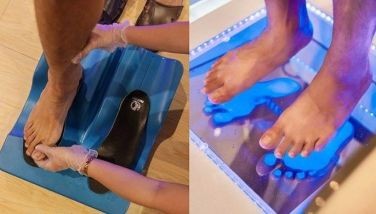By their lonesome

Last Monday, a three-year-old girl I know had her kiddie school class conducted for the first time by remote mode.
I’m not sure if this was because of the vog from the restive Taal Volcano, which forced the suspension of face-to-face classes in much of Calabarzon and, later in the day, in parts of Metro Manila. Maybe the girl’s teacher in the state-run school just wanted to test the digital competencies of her young students.
The girl is familiar with her mother’s smartphone, and settled easily into remote learning mode in the living room, saying hello to her teacher and classmates as they appeared one by one on screen.
Almost as soon as she could stand on her feet and walk steadily, the girl has been striking poses and making dance moves that are commonly seen on social media, particularly TikTok. She often greets people with “hello, guys” – a familiar greeting in online posts. She has picked up colloquialisms such as “sana all.”
In recent months, the girl has learned to scroll through e-commerce websites, browsing through items for kids and pointing out what she likes. Her mother had to stress that if she ordered anything online without notifying the adults who would pay for it, she would be deprived of cell phone use and her TV kiddie animation favorites, South Korea’s “Larva” and Russia’s “Masha and the Bear.”
The girl is physically active and sociable, but is becoming increasingly engrossed with the smartphone. Threats of depriving her of anything must be done sparingly. She shoots back that she’s sick of her home and would run away, never to come back. It’s doubtful that she learned this from Larva and Masha.
I wonder what her digital engagement will be like by the time she enters her teenage years. Will she be counted among the most lonesome youths on the planet, vulnerable to bullying especially online?
* * *
A Meta-Gallup poll conducted last year ranked the Philippines as the second loneliest country in the world, and the most lonesome in Southeast Asia.
In terms of demographics, among the loneliest Filipinos were Gen Zs – described by the Meta-Gallup study as those born between 1997 and 2012.
The loneliness was due partly to too much social media engagement and the use of smartphones, according to the poll. The study noted that having a parent or both parents working overseas compounded the problem, which was aggravated in recent years by COVID restrictions that forced a switch to remote learning.
Apart from engendering loneliness, social media has facilitated bullying in schools. Bullying has been cited as one of the factors for the poor performance of 15-year-old Filipino students who participated in two rounds of the Program for International Student Assessment. The PISA results placed the Filipinos at the bottom in terms of math and science competencies, reading comprehension and creative thinking.
PISA has tagged the Philippines as “the bullying capital of the world.”
The problem has prompted new Education Secretary Sonny Angara to remind all elementary and secondary schools both public and private that they are mandated to develop anti-bullying programs, under Republic Act 10627 or the Anti-Bullying Act of 2013.
As in most laws in this country, implementation is a problem in RA 10627. And a major reason is an acute lack of mental health professionals.
Before the COVID pandemic, an estimated 3.6 million Filipinos were reported to have mental health problems.
As of April this year, however, Department of Health (DOH) data showed that the country had only 651 working psychiatrists, 516 psychiatric nurses and 133 psychologists.
The DOH is providing free e-learning modules on mental health and psychosocial support services. As of last April, 2,548 health personnel and 1,259 rural health units had undergone MHPSS training.
Most schools lack guidance counselors. Their tasks usually fall on teachers, who are often overburdened enough with their regular duties, and could be suffering themselves from mental health issues. Teaching can be highly stressful. We saw this recently in that teacher who was caught on video losing it and unleashing a verbal harangue against her students.
It will take years before the lack of mental health workers can be corrected. For a long time, mental health problems were not taken seriously in our country. Among those considering a career in medicine, psychiatry has ranked low in the totem pole of preferences.
I myself, at one point in college, considered a career in mental health care, because I got top grades in all my psychology classes and I enjoyed the subject. But I worried that I would end up jobless, or “infected” by those who at the time were described as “saykopatik.”
* * *
Today, there’s lingering stigma attached to mental health problems, and people are still reluctant to seek help. There are emergency rooms for people who collapse or experience intense suffering from physical afflictions, but there’s no emergency room for people on the verge of suicide. They land in the ER only when they actually harm themselves, and tragically, it’s often too late.
We have seen from numerous documented cases that bullying in school not only affects academic performance, but can also lead victims to self-harm and suicidal thoughts.
Mental health hotlines operated by both private groups and the government report being swamped, even after the pandemic lockdowns.
Early childhood advocates say those two years of remote learning, with students isolated from the world, rendered many young children unable to socialize when face-to-face classes resumed.
The kids, of course, became quite familiar with the gadgets that they were required to use for remote learning. They are equipped for the digital age.
Today’s younger generations may not even be aware of what a lonesome existence it is to have smartphones, laptops and TV sets as constant company in place of regular face-to-face human interaction.
I know parents who lament that their children use cell phones to communicate even when they are gathered together at the table for a meal.
The three-year-old girl takes her meals while watching TV. She sips milk from a feeding bottle while scrolling through her mother’s smartphone.
She is certain to grow up digitally savvy. But at age 15, will she be bullied, and lonely?
Perhaps by the time she reaches her teenage years, there will at least be enough mental health professionals to give her any needed care.
- Latest
- Trending



























